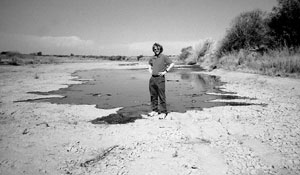 Earlier this month, Congress held a hearing on a bill to implement the San Joaquin River restoration settlement. The legislation is one of the final hurdles on the long track to what arguably will be the longest river restoration in North America.
Earlier this month, Congress held a hearing on a bill to implement the San Joaquin River restoration settlement. The legislation is one of the final hurdles on the long track to what arguably will be the longest river restoration in North America.
At one time the San Joaquin River-- California’s 2nd longest -- flowed more than 350 miles from its headwaters in the southern Sierra to the Delta and into San Francisco Bay. Paddlewheelers plied the river as far as Fresno. Each spring, some 300,000 Chinook salmon made the journey from the Pacific up the river to spawn-- the state’s largest and southern-most spring Chinook salmon run. The fish, well-adapted to the snowmelt runoff system of the Sierra, were so plentiful they were harvested for hog feed, and the sound of their splashing was said to keep folks up at night.
Now you are lucky to hear even a trickle of water.
In the 1940s, Friant Dam was constructed near Fresno, redirecting the water to growers in the eastern and southern San Joaquin Valley. As operated, the dam diverted nearly every drop in the river in most years, reducing about 60 miles of it to dust and severing at the hip a large piece of the watershed that once drained to the Bay. For a time, state fish and game officials struggled to keep the salmon runs alive, even loading the fish into tanks to truck them around dry reaches. But by the 1950s, the fish were gone.
In 1988, a coalition of environmental organizations (including The Bay Institute) filed suit, arguing in part that the operation of the dam violated Section 5937 of the California Fish & Game Code. This law requires dam owners (in this case, the federal government) to release enough water to keep fish below the dam "in good condition." In 2006, after an eighteen-year legal battle, a federal court approved a settlement that will restore year-round flows to the river and reintroduce salmon before 2013.
